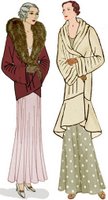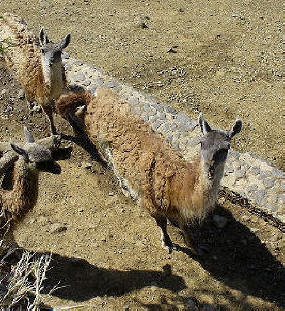Sunday, June 25, 2006
General: Presentation Pet Peeves
Sunday, June 18, 2006
Book: Fairchild Encyclopedia of Fashion Accessories
Fairchild Encyclopedia of Fashion Accessories
Sewing Project: You Decide

Parisienne Coat - authentic vintage pattern from 1931. You decide: cool? I'm thinking of sewing the coat on the right, with optional flounce, in a solid color... From Decades of Style Patterns. $20.
Resort 2007: Oscar de la Renta

Check out Oscar de la Renta's Resort 2007 collection. Lots of what you would expect: black/white, navy/white, crochet, nude textured hose - but done nicely. Very wearable.
Product Knowledge: Shoes: John Fluevog, again

I can't help it. I love his shoes. This is the new, limited edition Tracey. According to the e-mail, this is Fluevog's highest heel yet. $179.
The Camelids: A Picture Review
Alpaca

Llama

Guanaco

Vicuna



The Vicuna
 Long overdue, some information on the wonderful Vicuna.
Long overdue, some information on the wonderful Vicuna.Vicunas are the spirit and the life blood of the camelid families living in the high Andes. Unfortunately, due to their very valuable fleece vicunas were nearly hunted to extinction by the late l970s. Conservation efforts in Peru, Chile and Argentina have led to a phenomenal resurgence in vicuna populations. Once again, due to careful management, vicunas can be found in healthy numbers in the Andes.
Vicunas (Vicugna vicugna) are members of the Camelidae family, of which there are three other living members in South America: the wild guanaco (Lama guanacoe), the domestic llama (Lama glama), and the alpaca (Lama pacos).
 The smallest of all camels, the vicuna weighs about 90 pounds and stands just under three feet at the shoulder. Like all South American camel species, the vicuna has a long, supple neck; slender legs; padded, cloven feet; large round eyes; and a dense and fine tawny coat.
The smallest of all camels, the vicuna weighs about 90 pounds and stands just under three feet at the shoulder. Like all South American camel species, the vicuna has a long, supple neck; slender legs; padded, cloven feet; large round eyes; and a dense and fine tawny coat.The vicuna is a hardy survivor adapted to high altitudes, where drought and freezing nights are the rule. It is a natural pacer and well designed to travel fast for great distances. Keen eyesight allows early detection for flights to safety.
 The vicuna is the probable wild progenitor of the domestic alpaca, which was created by selective breeding about 6000 years ago. Entirely wild, vicunas live in small family groups led by a single territorial male that vigilantly repels rival males and small predators threatening the young. After 11 months of gestation, vicuna mothers give birth to one baby, known as a cria.
The vicuna is the probable wild progenitor of the domestic alpaca, which was created by selective breeding about 6000 years ago. Entirely wild, vicunas live in small family groups led by a single territorial male that vigilantly repels rival males and small predators threatening the young. After 11 months of gestation, vicuna mothers give birth to one baby, known as a cria.
Vicunas are highly communicative, signaling one another with body postures, ear and tail placement, and numerous other subtle movements. Their vocalizations include an alarm call -- a high pitched whinny -- that alerts the herd to danger. They also emit a soft humming sound to signal bonding or greeting and a range of guttural sounds that communicate anger and fear. "Orgling" is probably their most unique noise. This male-only, melodic mating sound attracts unbred females.
(Stolen without shame from: Bonny Doon Alpacas: Breeding Beauty in the Fleece.)Saturday, June 17, 2006
Friday, June 16, 2006
New Magazine: Adorn
 Try not to be offended...
Try not to be offended...Adorn: The Crafty Girl's Guide to Embellishing Life
"devoted to women who know that making something personal is as rewarding as it is fashionable"
$4.99
Monday, June 05, 2006
FYI: Hylexin (It works! It works!)
 It may cost a whopping $95 for the tube, but you only use a tiny amount and it works! The purple color from the corners is not totally eliminated, but the "black" and and crevices from the bags are gone.
It may cost a whopping $95 for the tube, but you only use a tiny amount and it works! The purple color from the corners is not totally eliminated, but the "black" and and crevices from the bags are gone.Now Bosley can stop asking if I have luggage to match my bags...
History: Sewing machine drama continues...
This Sunday's New York Times (4 June 2006) has an article on Sterling and Stephen Clark, heirs to the Singer sewing machine fortune.
"In earlier years they had a close kinship based on a shared passion for art. But in their distinct personalities lay the makings of a classic Dionysian-Apollonian conflict. They eventually fell out over the family riches, and, yes, a woman was involved. "May God curse him on earth as well as in heaven," Sterling said of Stephen."
History: Triangle Shirtwaist Factory Fire
It reminded me, however, of one of the largest ethical concerns that we face as as fashion students and potentially fashion professionals: labor.
On March 25, 1911, 146 people died in the fire at the factory, many of them teenaged girls. As you probably remember, most of them perished trapped behind locked exit doors or when the shoddy fire escape collapsed. Many of them lept to their death on the cobblestones, nine stories below them. Of course, many laws were then enacted in an attempt to prevent such a tragedy from happening again. However, these laws only apply to legal business in the United States, and therefore, only protect a small minority of textile workers.
So the next time that you complain about the price of clothing... Or when calculating dollars and cents on a cost sheet for work or school... Remember that there are lives attached to these financial figures - whole and complete lives - with dreams and hopes for the future.
[Jo Ann steps off the soapbox.]
Product Knowledge - Sloper
Sunday, June 04, 2006
FYI: SoHo Nail
SoHo Nail
458 West Broadway, third floor (near Canal)
212-475-6368
A favorite of fashionistas, SoHo Nail boasts possibly the least
expensive ($20) quality manicure-pedicure in town.
Open Monday-Saturday. Credit cards accepted. Appointment suggested.
Ask for Mimi.... Brazilian wax is $20....
One Day Symposium at the Museum at FIT
Saturday, September 9, 2006
9:00am - 5:00pm
Modern fashion is often inspired by what might be called the discourse of silk and steel. As designers seek to express both sensuality and power, they draw on two important sources of inspiration: lingerie and armor. This program will explore historical and contemporary issues of armor and intimate apparel in fashion. Speakers will include Jeffrey Forgeng, Higgins Armory Museum; Ruel Macaraeg, fashion historian; Tanya Marcuse, photographer; Tricia Rose, professor of American Studies at UC Santa Cruz, and Valerie Steele, director of The Museum at FIT.
Additional speakers and a schedule for the day have yet to be determined.
Please visit the MFIT website later in the summer for further details.
Current Exhibition at the Museum at FIT
May 23 - November 4, 2006
Tailoring has had a profound influence on fashion for both men and women. In contrast to draping, a relatively modern invention, tailoring was truly the first form of constructed dressmaking. Unlike ethnographic clothing, tailoring highlights the idealized human form. The man’s suit, the quintessential tailored garment, came into being in the 18th century and was “the” modern ensemble. Tailored menswear took a leadership role in pushing women’s fashion forward.
The Tailor’s Art includes tailored fashions for women as well as styles that are the antithesis of the man’s somber suit. This exploration of gender differences also features examples of ornamental waistcoats and dressing gowns, and a range of menswear, such as the cowboy suit and counterculture clothing that adds visual and intellectual excitement.
Image Credit: Jacket - tan wool with black soutache and fur trim - France, c.1895 - gift of Mr. Joe Simms - Photo by Irving Solero.
Upcoming Exhibition at the Museum at FIT
September 9 - December 16, 2006
“If lingerie is like soft skin, armor is a hard exoskeleton,” said Dr. Valerie Steele, director and chief curator of The Museum at FIT. “Lingerie symbolizes nakedness, intimacy and seduction, while armor is associated with authority, protection and discipline.” Different designers have, of course, focused on different aspects of this theme. Jean Paul Gaultier designed a camouflage ballgown for the haute couture, while Thierry Mugler envisioned sexy robots with hard, metallic bodies. The British design team Boudicca creates styles that evoke transgressive warrior women, and Junya Watanabe channels chic soldier boys. Both Narciso Rodriquez and Alexander McQueen have juxtaposed silk with chain mail.
The exhibition is organized by Dr. Steele; Patricia Mears, research curator; and Fred Dennis, associate curator of costume.

